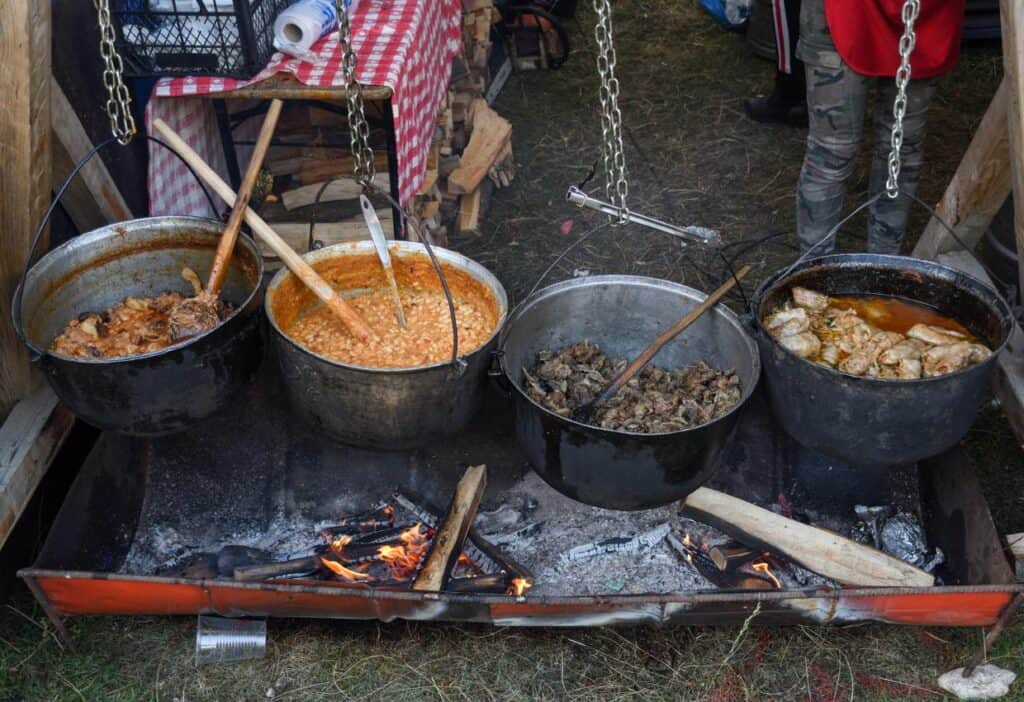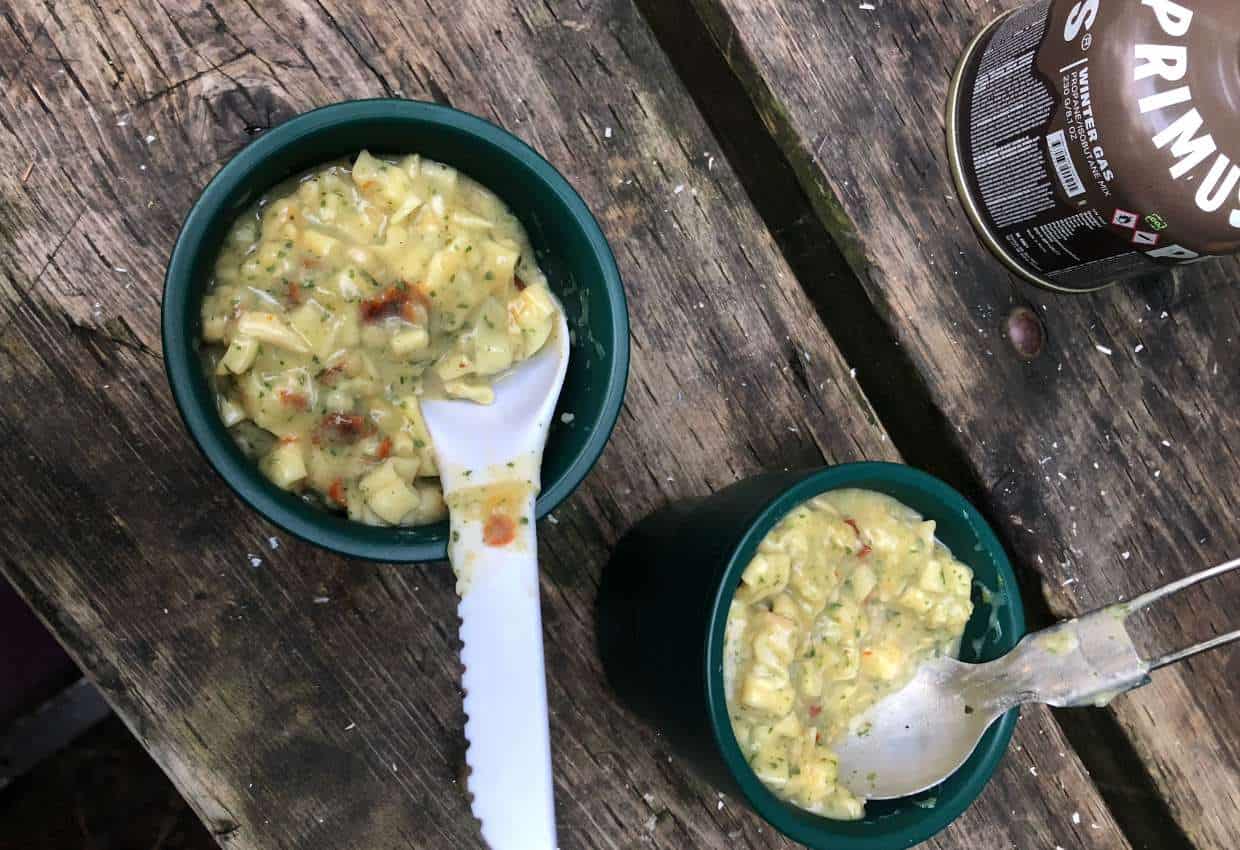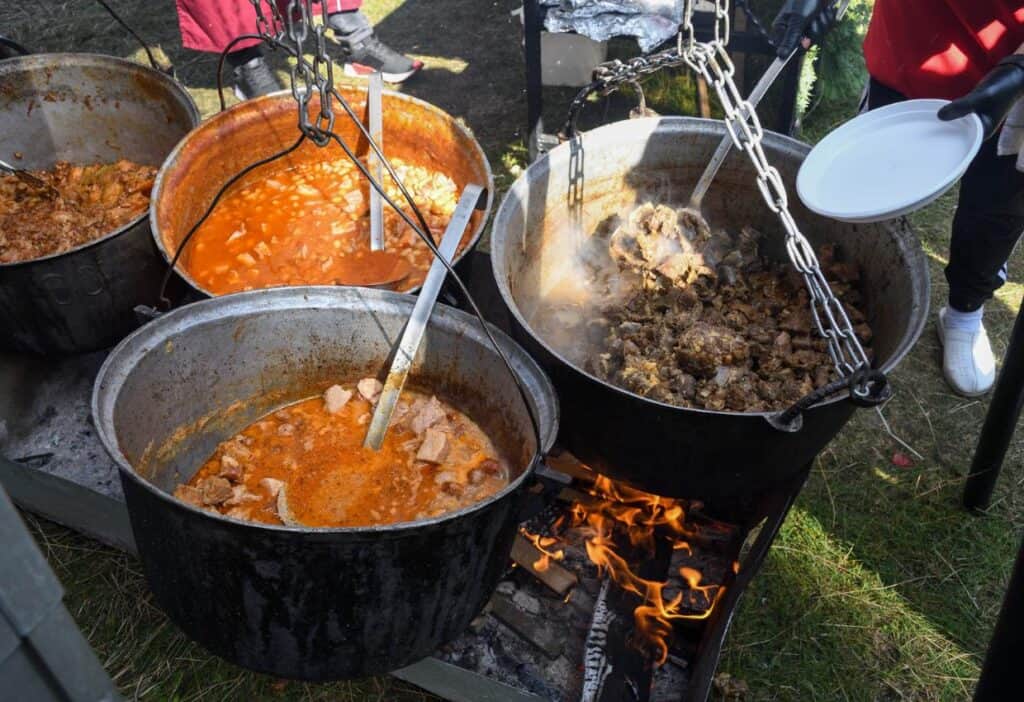Are you going tent camping this summer? No microwaves, Uber Eats, and or restaurants in the wild means you’ll need to bring food, cooking equipment and supplies. Here’s what you need to know about planning your camping kitchen setup.

You dream of early morning fishing, afternoon hikes and evenings playing family board games by the light of a campfire or lantern. But wait — all that outdoor time means you’ll be hungry.
Organizing your camping kitchen before heading out can make all the difference between a miserable trip and one for the memory books. Take the time to plan your setup before you go so you can relax and enjoy the time outdoors.
What is a camping kitchen?
A camping kitchen is an organized outdoor workspace for meal preparation. It may include areas for prep and cooking, storage and washing. In addition, it often includes an open fire with a cooking grate or a portable cookstove, barbecue or grill.
From an elaborate fold-out all-in-one camp kitchen to a simple frying pan and saucepan combo, your outdoor cooking setup should reflect your camping needs and wants.
“I always set up a dishwashing station first. A tub for dirty dishes that can be filled hot with soapy water (use biodegradable dish soap!) and a collapsible tub for rinse water. Next, set up a stove with enough room around it to have ingredients and serving dishes at the ready before you start to cook.”
— Robin Donovan, All Ways Delicious
What do you need?

When planning a camping trip, only bring items you’ll use. Food, water, a small cooler, frying pan and pot, outdoor serving ware and a portable grill or 2-burner Coleman camp stove may suffice for car camping.
For longer trips or to serve more elaborate meals, bring a Blackstone griddle, a large Yeti cooler and a cast-iron Dutch oven.
You’ll find many space-saving gadgets to simplify camping meal prep and cooking, but don’t get tempted to waste your money on things you won’t use.
“I love bringing my portable Blackstone griddle for camping. It runs off the little propane tanks, so there is no need to have a fire and worry about getting your cast iron to heat up correctly or getting ash into your food. You can make a variety of delicious and healthy meals on the Blackstone!”— Lara Clevenger MSH, RDN, CPT LaraClevenger.com
How to set up a camping kitchen

Plan ahead to minimize the chances of forgetting something. This also gives you time to think about how to arrange the outdoor kitchen at your campsite.
Follow these five tips to save time, money and frustration outfitting and using your camping kitchen.
1. Consider your numbers
How many campers will be joining you? A family of four on a week-long camping trip needs more food, not to mention food storage room, table space and seating, than a couple camping for the weekend.
Set up your kitchen with a safe space between the cooking and seating areas, an important tip if camping with kids. Review camping safety rules with younger family members, especially if you cook over an open fire.
Each camper will need a cup, plate, bowl and cutlery. Make a note of food allergies and preferences when planning your meals.
2. Cooking, grilling or cold food
Do you want to grill, barbecue or eat cold or prepared foods on your trip? This determines which food items, ingredients and cooking equipment you’ll need when camping.
Also, consider the climate and trip length when planning your meals. Don’t overpack foods in your cooler, especially if you camp for more than 48 hours in hot weather. Ice packs may melt, causing food spoilage in warmer temperatures. Instead, make cold dinners or dishes using dry goods such as pasta, canned vegetables and legumes.
3. Research camp cooking equipment
Today’s campers use various outdoor cooking equipment, from basic cookware to portable solar ovens. Here are a few items to consider.
- All-in-one food prep units or modular setups: Collapsible outdoor kitchens offer convenience and space for food prep, cooking, and clean-up. However, they can be expensive and take up precious cargo space when traveling.
- Portable sinks, drain tubs or buckets: Collapsible drain tubs or a small Rubbermaid bucket can serve as a dishwashing station.
- Essential cleaning supplies: Remember items like biodegradable soap, scrub brushes, and dish towels.
- Often overlooked items: Pack a good knife set, matches and lighter, cutting board, tongs, spatula, can opener and oven mitts.
“We do remote tent camping, so preparation is everything, and because we are hiking long distances, we don’t carry a lot of items. These items are a must in the camp kitchen: A water purifier, resealable plastic bags, which are small and lightweight and good for storing all sorts of things, waterproof matches for starting fires, a collapsible cooking pot, bowls, cups, and a plastic drip coffee cone, because we need our coffee in the wilderness.”
— Jere’ Cassidy, One Hot Oven
4. Camp cooking essentials vs. luxuries
Before you go, identify the camp cooking essentials and the luxuries you could do without. Pack camping gear and your camp cooking essentials first. Then add luxury items if you have space.
You likely need a good camp stove (and fuel) for preparing meals for car camping, especially in areas with fire bans preventing cooking over an open fire.
A portable or charcoal grill can be a great addition to your setup if you like grilled meats or veggies. If backpacking, choose a lightweight camp stove instead.
You’ll also need some camping cookware. For example, a Dutch oven is a versatile piece of cookware for cooking, baking, and frying, but it’s heavy. Alternatively, bring a cast-iron skillet to cook everything from pancakes to stir-fry.
You’ll also need to get and store drinking water. Consider buying a portable Berkey Water Filter or LifeStraw if you’re camping near a freshwater source. Bring a collapsible water container if your campground offers potable water.
5. Campsite features
When you arrive at your campsite, take a look around before unpacking because your campsite environment impacts your camping kitchen setup.
Do you see a shady area to store your cooler? Do wolves or raccoons visit the area? If so, you may need to store your food in your vehicle overnight.
Are you camping in bear country? If so, you need to store food in bear lockers or bear canisters. And if camping in an area with insects, invest in a screen tent to erect around the picnic table for food prep and serving meals.
Plan your camp kitchen before you go

Take your time with outfitting and setting up a camp kitchen to make meal prep as easy as possible when camping.
Choose camping cooking equipment to fit your budget and menu style, invest in quality cooking tools and consider your campers’ food and meal prep preferences.
Whether planning a weekend camping trip with your friends or a week-long family summer camping adventure, a well-equipped camping kitchen can help make your next outdoor adventure a success.
Sarita Harbour is a homeschooling, homesteading mom and a long-time business and finance writer. Sarita created An Off Grid Life to help people become more self-reliant. Sarita and her family live off the grid in Canada’s Northwest Territories.